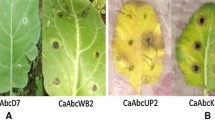Abstract
Vegetative compatibility among 17 isolates ofVerticillium dahliae obtained from watermelon, originating from eight regions of Greece, was investigated using complementation tests between nitrate-nonutilizing(nit) mutants. Among 529 chlorate-resistant sectors obtained, only 107 werenit mutants. These mutants were paired with tester strains (from Greece and other countries) of previously described vegetative compatibility groups (VCGs), and also were paired in many combinations among themselves. All isolates were self-compatible. Sixteen isolates were found to belong to VCG2. Only isolate V75 could not be assigned to a VCG, because the threenit mutants obtained from it showed negative reactions with the tester strains of four VCGs and with complementary mutants from other isolates. Based on this sample, we conclude that the population ofV. dahliae from watermelon in Greece is homogeneous in respect to VCG.
Similar content being viewed by others
References
Bao, J.R., Katan, J., Shabi, E. and Katan, T. (1998) Vegetative-compatibility groups inVerticillium dahliae from Israel.Eur. J. Plant Pathol. 104:263–269.
Blancard, D., Lecoq, H. and Pitrat, M. (1994) A Colour Atlas of Cucurbit Diseases, Observation, Identification and Control. Manson Publishing Ltd., London, UK.
Booth, C. (1970)Fusarium oxysporum. Descriptions of pathogenic fungi and bacteria. C.M.I. No. 211.
Booth, C. (1971) The GenusFusarium. Commonwealth Agricultural Bureaux, UK.
Chen, W. (1994) Vegetative compatibility groups ofVerticillium dahliae from ornamental woody plants.Phytopathology 84:214–219.
Correll, J.C., Klittich, C.G.R. and Leslie, J.F. (1987) Nitrate nonutilizing mutants ofFusarium oxysporum and their use in vegetative compatibility tests.Phytopathology 77:1640–1646.
Daayf, F., Nicole, M. and Geiger, J. (1995) Differentiation ofVerticillium dahliae populations on the basis of vegetative compatibility and pathogenicity on cotton.Eur. J. Plant Pathol. 101:69–79.
Elena, K. (1997) Genetic relatedness ofVerticillium dahliae isolates from cotton, tomato and watermelon plants.Abstr. 7th Int. Verticillium Symp. (Cape Sounion, Athens, Greece), p. 27.
Elena, K. (1999) Genetic relationship ofVerticillium dahliae isolates from cotton, based on vegetative compatibility.Eur. J. Plant Pathol. 105:609–616.
Elena, K. (1999) The vascular wilt fungi of tomato in Greece: vegetative compatibility groups ofVerticillium dahliae. Phytopathol. Mediterr. 38: (in press).
Elena, K. and Paplomatas, E.J. (1998) Vegetative compatibility groups ofVerticillium dahliae from different hosts in Greece.Plant Pathol. 47:635–640.
Gubler, W.D. (1996) Verticillium wilt.in: Zitter, T.A., Hopkins, L.D. and Thomas, C.E. [Eds.] Compendium of Cucurbit Diseases. APS Press, St. Paul, MN, USA.
Hawksworth, D.L. and Talboys, P.W. (1970)Verticillium dahliae. Descriptions of pathogenic fungi and bacteria. C.M.I. No. 256.
Joaquim, T.R. and Rowe, R.C. (1990) Reassessment of vegetative compatibility relationships among strains ofVerticillium dahliae using nitrate nonutilizing mutants.Phytopathology 80:1160–1166.
Joaquim, T.R. and Rowe, R.C. (1991) Vegetative compatibility and virulence of strains ofVerticillium dahliae from soil and potato plants.Phytopathology 81:552–558.
Korolev, N. and Katan, T. (1997) Improved medium for selecting nitrate-nonutilizing(nit) mutants ofVerticillium dahliae. Phytopathology 87:1067–1070.
Matta, A., Cirulli, M., D’Ercole, N. and Ciccarese, F. (1980) Inelagini sulla specializzazione fisiologica diVerticillium dahliae Kleb, in Italia.Inf. Fitopatol. 11-12:5–11.
Puhalla, J.E. (1985) Classification of strains ofFusarium oxysporum on the basis of vegetative compatibility.Can. J. Bot. 63:179–183.
Puhalla, J.E. and Hummel, M. (1983) Vegetative compatibility groups withinVerticillium dahliae. Phytopathology 73:1305–1308.
Rouxel, F. and Bouhot, D. (1971) Recherches sur l‘ecology des champignons parasites dans le sol. IV. Nouvelles mises au point concernant l’analyse sélective et quantitative desFusarium oxysporum andFusarium solani dans le sol.Ann. Phytopathol. 3:171–188.
Rowe, R.C. (1995) Recent progress in understanding relationships betweenVerticillium species and subspecific groups.Phytoparasitica 23:31–38.
Schnathorst, W.C. and Mathre, D.E. (1966) Host range and differentiation of a severe form ofVerticillium albo-atrum in cotton.Phytopathology 56:1155–1161.
Strausbaugh. CA., Schroth, M.N., Weinhold, A.R. and Hancock, J.G.(1992) Assessment of vegetative compatibility ofVerticillium dahliae tester strains and isolates from California potatoes.Phytopathology 82:61–68.
Tjamos, E.C. (1980) Occurrence of race 2 ofVerticillium dahliae in Greece.Ann. Inst. Phytopathol. Benaki (N.S.) 12:216–226.
Vloutoglou, I., Paplomatas, E.J. and Lampropoulos, C.J. (1997) Differences in host reaction ofVerticillium dahliae isolates from tomato, cotton and watermelon.Abstr. 7th Int. Verticillium Symp. (Cape Sounion, Athens, Greece), p. 39.
Author information
Authors and Affiliations
Corresponding author
Rights and permissions
About this article
Cite this article
Elena, K. Vegetative Compatibility amongVerticillium dahliae Isolates from Watermelon in Greece. Phytoparasitica 28, 115–120 (2000). https://doi.org/10.1007/BF02981740
Received:
Revised:
Issue Date:
DOI: https://doi.org/10.1007/BF02981740




